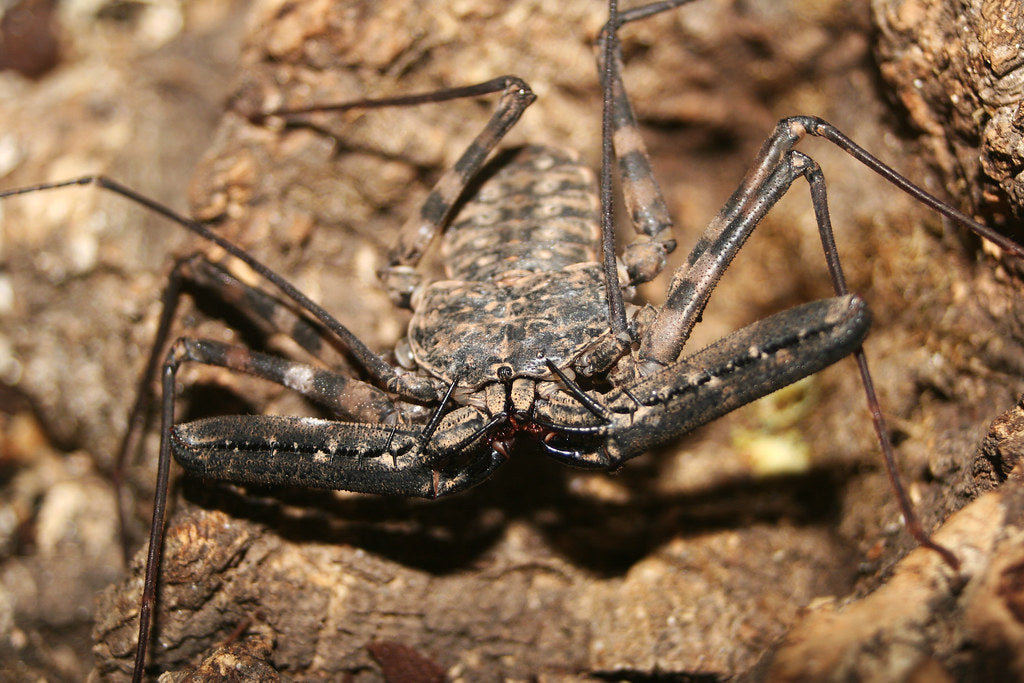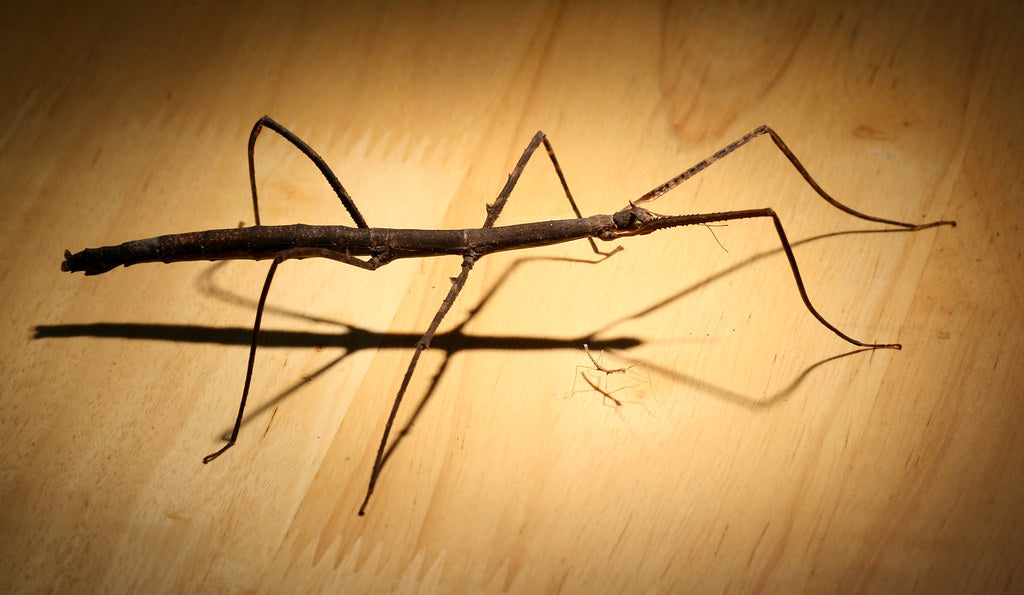The tailless whip scorpion (also known as a whip spider) is a group of arachnids under the order Amblypygi, with over 150 known species. These nocturnal invertebrates can be found all over the world, and generally prefer a vertically-oriented habitat. The most common species in the pet trade include:
- Charinus pescotti
- Damon diadema
- Damon medius
- Damon variegatus
- Phrynus marginemaculatus
Although exact size and appearance varies by species, tailless whip scorpions have a broad, extremely flat body, with a solid carapace and a segmented abdomen. Two eyes are located at the front of the carapace, and three additional eyes are located on each side. There are eight legs total, six used for walking and two used for sensation. When walking, tailless whip scorpions move side to side rather than forward and back. They can have as small as a 4” legspan, or as large as 10”. Males can be distinguished from females by their relatively long pedipalps.
Tailless whip scorpions are intermediate-level pet invertebrates due to their delicate bodies and high humidity needs. With good care, they can live 10-20 years, with females living significantly longer than males.
How much space do tailless whip scorpions need?
The general rule for selecting a tailless whip scorpion is that it should be twice your pet’s expected adult leg span in length, width, and height. For example, if your species of tailless whip scorpion is expected to get 6” across, then you will need an enclosure that measures at least 12”L x 12”H x 12”H. This enclosure should have a mesh top for ventilation and assistance in molting.
Tailless whip scorpions tend to be fairly active at night, so providing a larger setup is likely to be beneficial. Whatever you use, don’t forget to secure the enclosure well against escape!
Cohabitation (keeping multiple tailless whip scorpions in one enclosure) may be possible as long as the enclosure size is increased proportional to the number of animals it will be housing.
Do tailless whip scorpions need UVB?
No, they do not.
However, it is beneficial to provide a day/night cycle, and if you want to use live plants as part of the décor, you will need 6500K lighting to help keep them alive. Lights should be on for 12 hours/day, and there should still be plenty of shade for your scorpion to hide in during the day.
What basking temperatures do tailless whip scorpions need?
Tailless whip scorpions, like other invertebrates, are ectotherms, which means that they need to be kept within a specific range of temperatures in order to regulate their metabolism and stay healthy.
The optimal ambient temperature for tailless whip scorpions is generally between 65-77°F for tropical species, although semi-arid species are likely to appreciate access to a warmer basking area. Track the temperatures in your enclosure with a digital probe thermometer.
To provide supplementary heat to a tailless whip scorpion, use a Zoo Med Nano Dome Lamp Fixture with a low-wattage heat bulb like the 25w Zoo Med Nano Basking Spot or similar. Place this on the extreme left or right of the enclosure. Do not place the lamp on top of the mesh, as this can burn your pet if they climb on the mesh. Instead, suspend the lamp from a Zoo Med Reptile Lamp Stand or similar. The heat lamp should be turned off every night.
What humidity levels do tailless whip scorpions need?
Tailless whip scorpions generally prefer high humidity conditions between 70-90%, but the semi-arid species can be kept lower at 65-75%.
You can maintain these levels by moistening the substrate and misting the enclosure regularly. However, make sure that the substrate is never swampy or soaked. The top layer of substrate should always be moist. You can also maintain healthy humidity levels by spraying down the enclosure 1-2x/day.
You can measure ambient humidity levels with a digital probe hygrometer.
What substrate is good for tailless whip scorpions?
Your setup will need at least 2” of moisture-friendly substrate to facilitate humidity. We recommend the following substrates for this species:
Replace the substrate and completely clean the enclosure every other month. Setting up a bioactive environment with clean-up crew organisms, live plants, and plant lighting can be a good way to reduce the stress of routine cleanouts.
What décor can you use in a tailless whip scorpion terrarium?
Tailless whip scorpions may not seem to do much, but it’s still beneficial to give them items in their enclosure that they can explore and use to express natural behaviors. It also makes the enclosure more attractive!
At minimum, your tailless whip scorpion needs some vertically-oriented cork flats to hide between and climb on. However, additional options include:
- low branches
- cork flats
- live or artificial plants
- artificial ornaments
Make sure all décor is well-secured so that it can’t accidentally fall on top of your pet!
What do tailless whip scorpions eat?
Tailless whip scorpions are carnivores, which means that they need whole insect prey in order to get the nutrition that they need. Each meal should be roughly 1/4 your pet’s body size. Crickets, dubia roach nymphs, and discoid roach nymphs are good options for feeders. Offer food once per week.
Remove all uneaten prey within 24 hours to prevent the prey from stressing or even injuring your pet.
Water
Aside from daily misting, your tailless whip scorpion should have free access to a shallow water dish for drinking. Change the water daily and scrub the bowl with an invertebrate-safe disinfectant weekly.
Do tailless whip scorpions like to be handled?
As a general rule, it’s best not to handle tailless whip scorpions. Although they are harmless to humans (aside from the occasional pinch), tailless whip scorpions have very delicate bodies and can be easily injured by human hands.
If you need to move your tailless whip scorpion, coax it onto a piece of bark rather than grabbing it with your hand. Avoid disturbing your pet 7-10 days after molting, as they are particularly fragile during this time as their new exoskeleton hardens.
*This care sheet contains only very basic information. Although it’s a good introduction, please do further research with high-quality sources to obtain additional information on caring for this species.
"Tailless Whip Scorpion" by Destinys Agent is licensed under CC BY-NC 2.0



Leave a comment
This site is protected by hCaptcha and the hCaptcha Privacy Policy and Terms of Service apply.